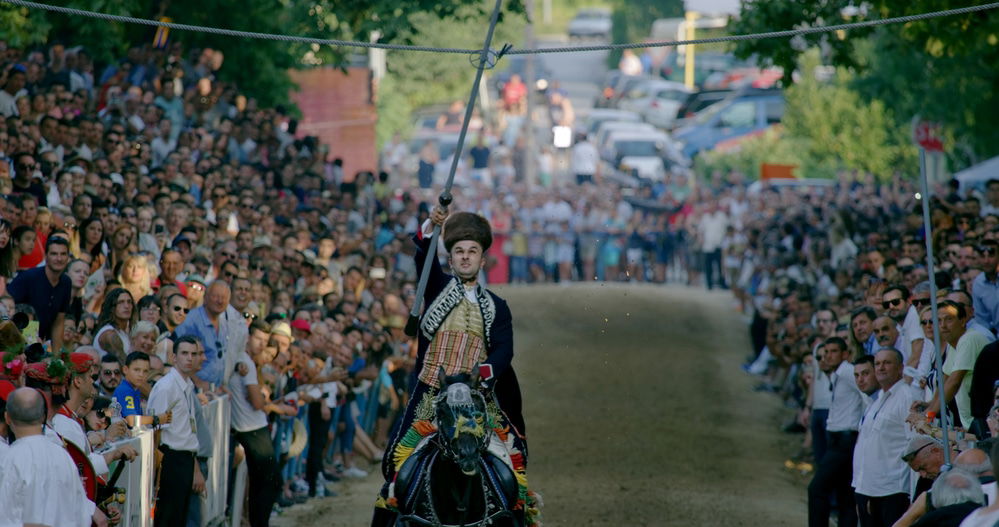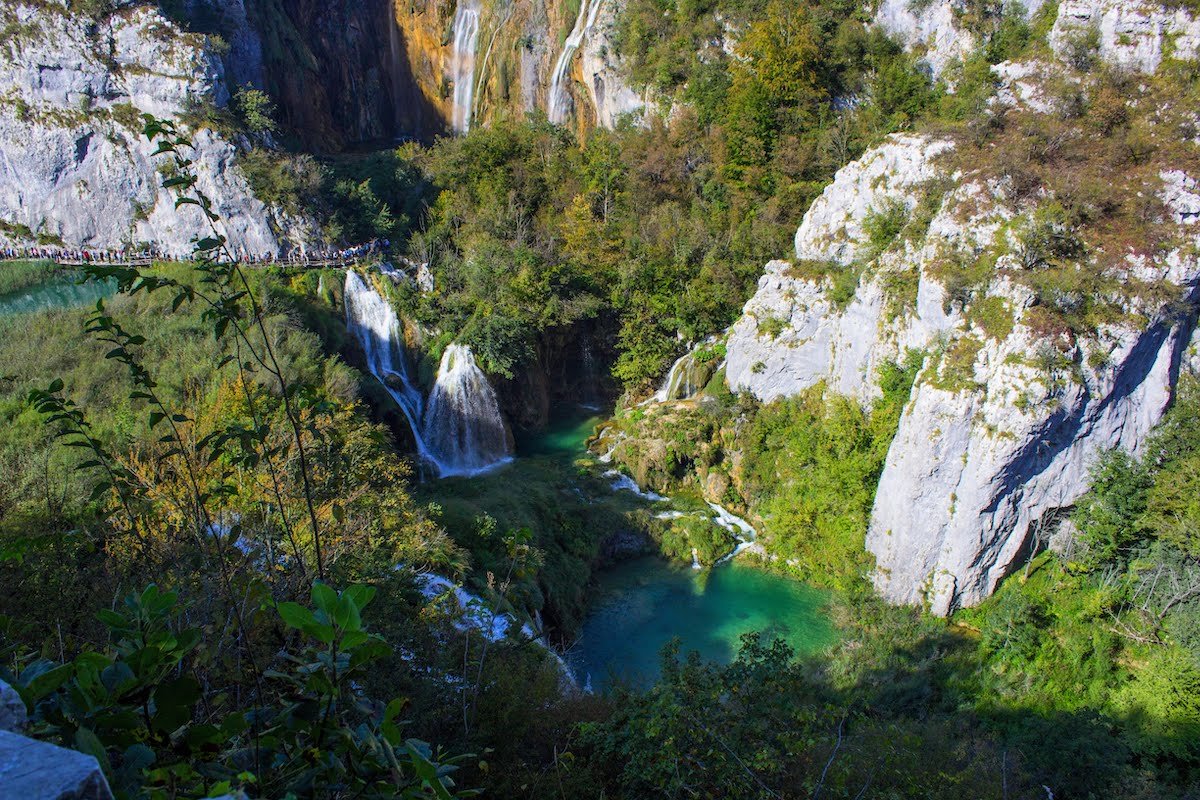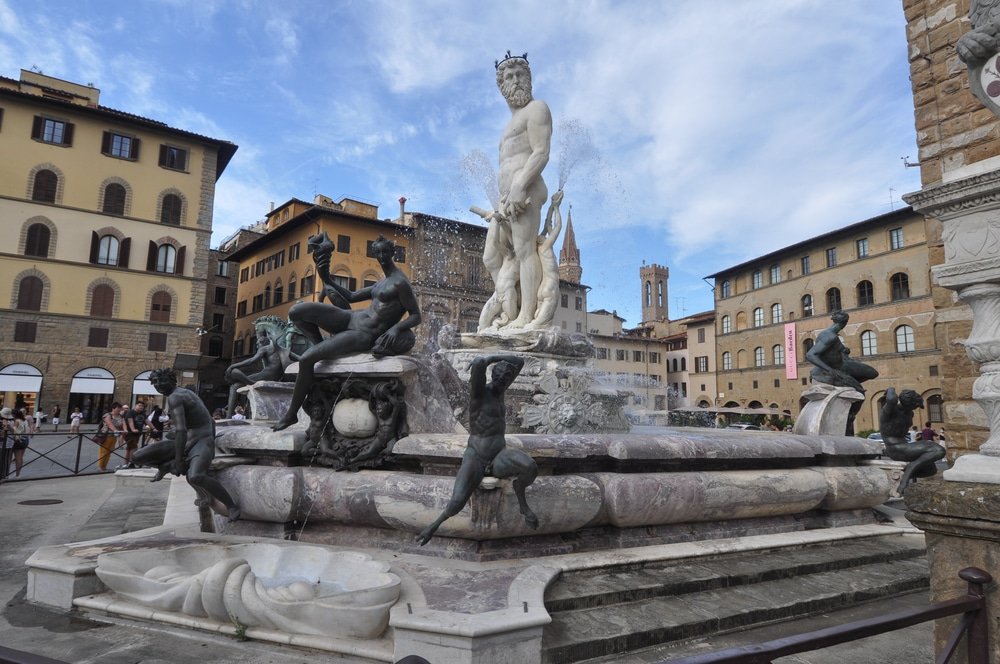In this article, I’m excited to share with you all that I’ve learned about Croatia and Italy, drawn from my own life in Croatia and numerous journeys to Italy.
As a resident of Croatia, a seasoned traveler to Italy, and an enthusiast for all things Mediterranean, I bring a unique perspective to help you navigate these two amazing destinations.
Let’s delve into the distinct qualities that make both countries remarkable. Croatia and Italy are akin to two sides of the same Mediterranean coin, each boasting a blend of delicious food, historical marvels, small and large cities, a Mediterranean climate, blue waters, and modern flair, yet each with its own uniqueness.
I’ll guide you through the must-visit locations, hidden treasures, and cultural experiences that define these places.

Living in Croatia, I’ve come to appreciate its more than just breathtaking coastlines. Italy, which I’ve visited frequently, delights with its timeless art, delectable cuisine, and picturesque landscapes.
In comparing these two destinations, I’ll provide insights to help you determine which might be the perfect choice for your next journey.
So, come along, let’s embark on this adventure to uncover the distinct allure that both Croatia and Italy have to offer.
Skip Ahead To My Advice Here!
Reasons To Go To Croatia
1. Rijeka
Rijeka might not be the first name that pops up for a Croatian getaway, but trust me, it’s a hidden treasure, especially for island hoppers. This city’s got a mix of industrial feel and easy access to serene islands.
2. Rovinj
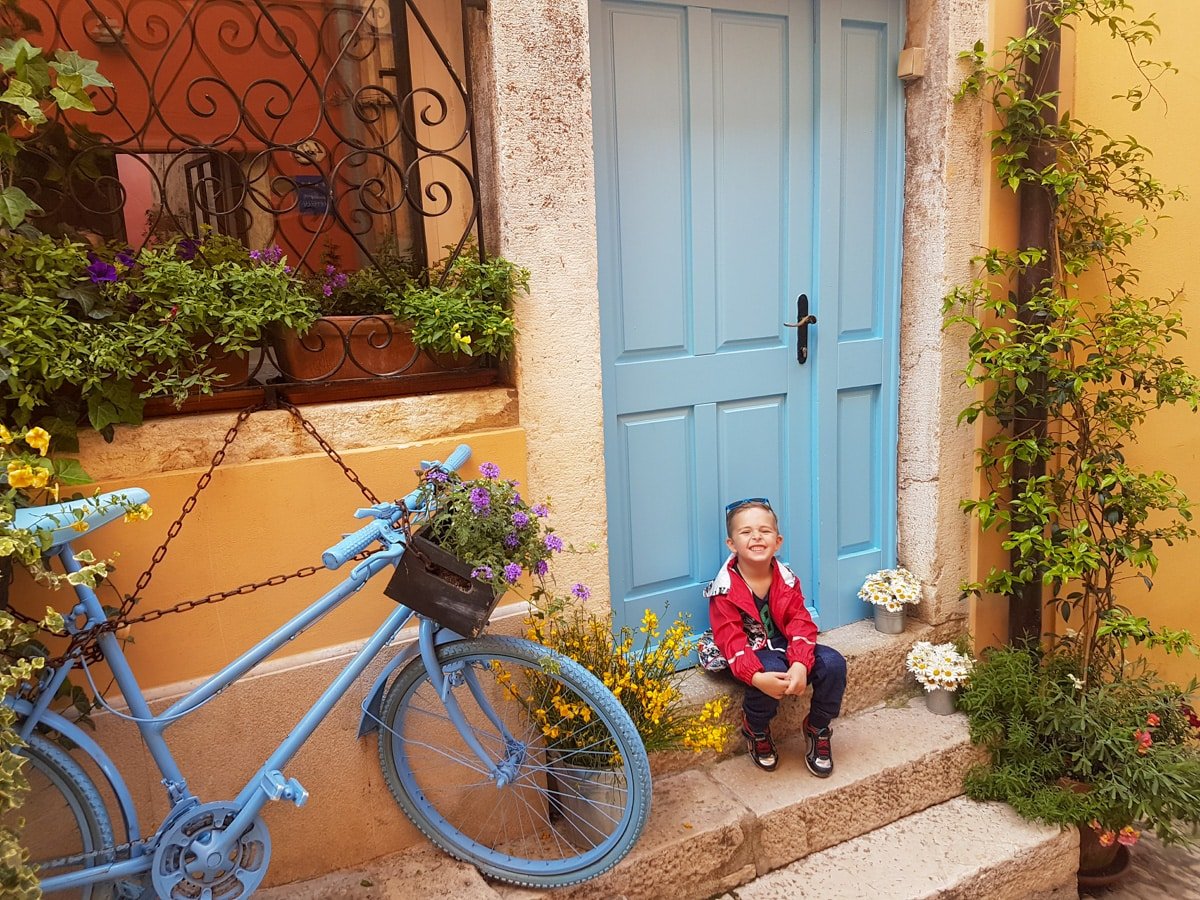
Rovinj is more than its Instagram-worthy views. Stroll down its cobblestone lanes and hang out at the vibrant harbor, and you’re in for a cultural treat. If you’re weighing Italy against Croatia, Rovinj’s authentic local vibe is something to consider.
3. Opatija
Opatija’s all about that Austro-Hungarian style with a seaside twist. Beyond its picturesque coast, this place is a nod to Croatia’s eco-friendly tourism. Wander along its classy promenades and soak in the cultural harmony.
4. Pula
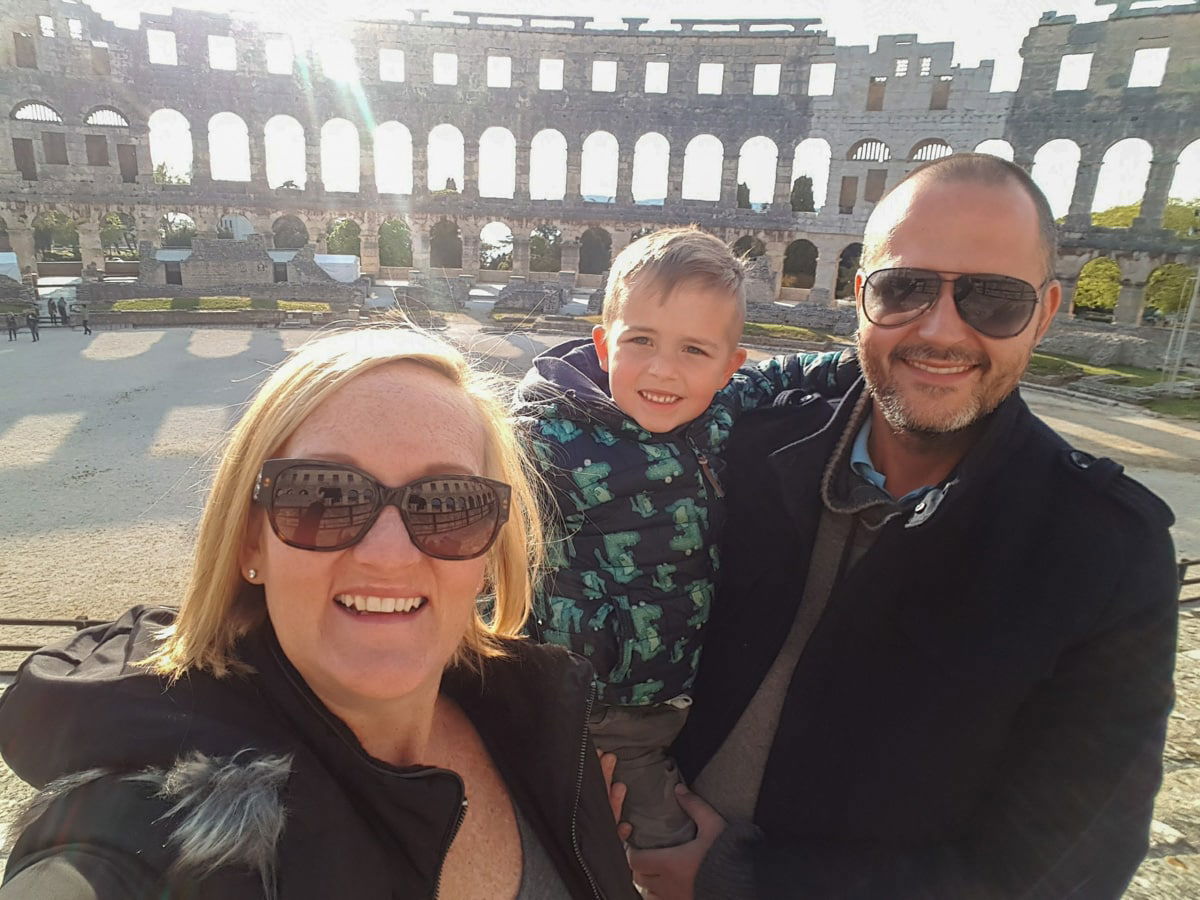
Let’s talk about Pula. It’s not just a city; it’s a time machine! The Roman Amphitheater here isn’t just a pile of old rocks; it’s a journey to an era long gone. If you’re juggling between Italy and Croatia for your next trip, Pula’s historical vibes might tip the scales.
5. Split
Split is where you’ll see Croatia’s past and present hanging out together. Walking through Diocletian’s Palace is like stepping into history but with a modern beat.
6. Croatia’s Coastline

Croatia’s coast is a mix of beautiful beaches, each offering something unique, from quiet spots to buzzing beach towns. If you’re deciding between Croatia and Italy, consider these coastal treasures in Croatia that are just waiting for you to explore.
|
Beach |
Location |
Unique Features |
|
Bol, Brac Island |
Natural masterpiece, Golden Horn shape, ever-evolving. |
|
|
Dubovica Beach |
Secluded escape surrounded by vineyards and a charming village. |
|
|
Sakarun Beach |
Powdery white sand, crystal-clear turquoise waters, a hidden gem. |
7. Croatian Festivals
Croatia’s festival scene really shines, especially if you’re into a vibrant mix of cultural and musical events. Let’s start with the Dubrovnik Summer Festival.
Here’s the scene: you’re in the walled city of Dubrovnik, a city that looks like it’s leaped out of a fairytale, surrounded by historic walls. This festival brings an array of performances, from music to theater and dance, blending classical and modern vibes. It’s a unique experience set in a stunning location that’s hard to beat.
Now, for a deep dive into Croatian history, the Sinjska Alka in Sinj is a must-see. This is not just any festival; it’s a medieval knight’s tournament, a tradition going strong since the 18th century. It’s a real-life history lesson, complete with knights in armor jousting it out. It’s a spectacular glimpse into Croatia’s past, brought to life in the present.
But wait, there’s more – especially if you’re into music. Head over to Zrće on Pag Island, renowned for its electrifying music festivals. This place is a haven for electronic music lovers.
Imagine beach parties, world-class DJs, and non-stop music, all in a picturesque island setting. It’s a hotspot for anyone looking to dance the night (and day) away in a breathtaking coastal setting.
Croatia’s festivals offer something for everyone. From historical reenactments to cutting-edge music parties, these events are more than just entertainment; they’re an insight into Croatia’s diverse culture and traditions.
When planning your trip, keep an eye on the festival calendar – you’re bound to find something that’ll be the highlight of your Croatian adventure.
8. Croatian National Parks
When you step into Croatia’s national parks, you step into some of Europe’s most stunning natural wonders. Plitvice Lakes National Park isn’t just a park; it’s a marvel with its waterfalls tumbling into vibrant green lakes – it’s like walking into a living postcard.
And then there’s Krka National Park. Imagine wandering through a labyrinth of waterways and waterfalls – it’s peace and adventure wrapped into one.
If you’re on the fence about choosing between Italy and Croatia, think about what kind of natural beauty speaks to you. These parks aren’t just sights to see; they’re experiences that stay with you.
Reasons To Go To Italy
1. Rome
Are you heading to Rome? Prepare to step back in time. The city is a live museum, with landmarks like the Colosseum and Vatican City telling tales of ancient grandeur.
2. Florence
Florence is a dream come true for fans of the Renaissance. Home to the Uffizi Gallery, where you’ll find works by the greats like Botticelli and Michelangelo, it’s a reminder of Italy’s deep artistic roots. If your heart’s torn between Italy and Croatia, the artistic charm of Florence could sway your decision.
3. Venice

Venice is a world of its own, a mesmerizing maze of canals flanked by historic buildings. Take a boat ride along the Grand Canal and witness the lavishness of Venetian life. If you’re stuck choosing between Italy and Croatia, Venice’s unique waterways and romantic vibe might be the clincher.
4. Italy’s Varied Landscapes
From Tuscany’s rolling hills to the Amalfi Coast’s dramatic cliffs, Italy’s landscapes are a feast for the eyes.
The Dolomites, a UNESCO World Heritage site, are a paradise for outdoor enthusiasts, while Umbria’s peaceful countryside offers a chance to unwind. When planning your trip, whether it’s from Croatia to Italy or vice versa, these diverse Italian landscapes are worth considering.
5. Exploring Italy’s Vibrant Festivals
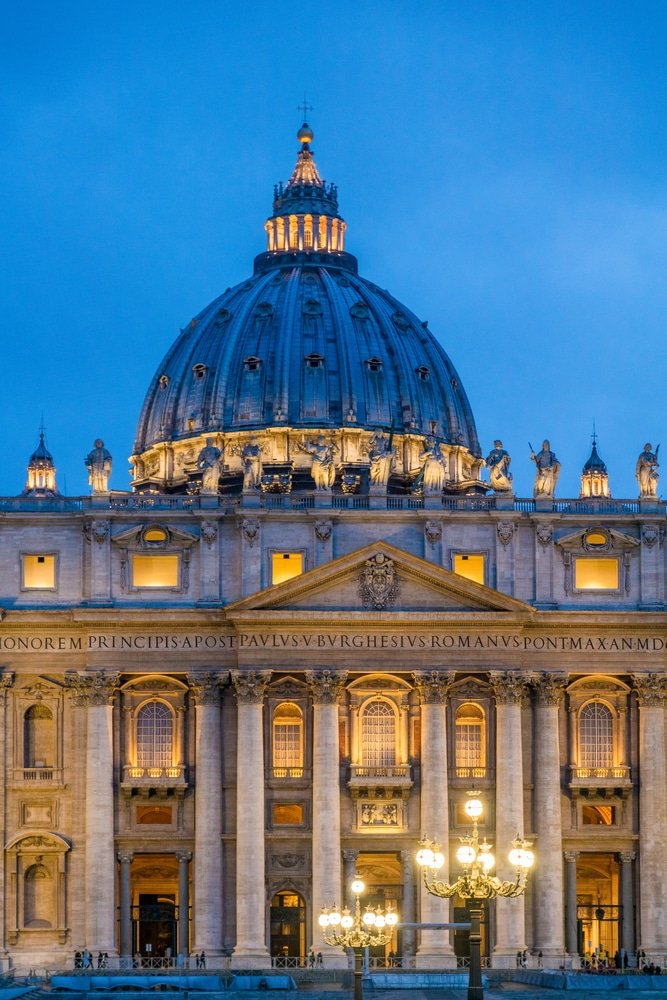
When you’re planning a trip to Italy, it’s not just about the iconic landmarks and mouth-watering cuisine; it’s also about immersing yourself in a world brimming with vibrant festivals.
These events are more than just parties; they’re a window into Italy’s soul, where history, religion, and art blend seamlessly.
Let’s start with the Venice Carnival. Imagine stepping into a painting where everyone is masked and costumed, turning the entire city into a scene straight out of a fantasy.
This isn’t just any carnival; it’s a historical journey that transforms Venice into a wonderland of mystery and elegance. The streets buzz with excitement, and the air is thick with anticipation as masked revelers parade around. If you’re a fan of the extraordinary, this is an event you won’t want to miss.
Next up, the Palio in Siena. This isn’t your average horse race. The Palio is steeped in history, dating back to the 17th century. There is fierce competition between the city’s districts, and the energy is electric.
The thunder of hooves, the passionate cheers of the crowd, and the colorful banners create an atmosphere that’s both thrilling and deeply rooted in tradition. If you’re in Siena during the Palio, you’re in for a treat.
But Italy’s festival scene isn’t just about these big names. Each region has its own unique celebrations. From the lemon festivals in the Amalfi Coast to the truffle fairs in Piedmont, every event is a unique expression of local culture and traditions. These festivals are the perfect opportunity to dive into the local lifestyle. You’ll get to enjoy authentic Italian food, music, and traditions that are hard to find anywhere else.
So, as you plan your Italian getaway, consider timing your visit to coincide with one of these incredible festivals. It’s not just about seeing a new place; it’s about experiencing it in full color and vitality.
Italy’s festivals offer a chance to see the country through the eyes of its people and trust me; it’s an experience that’s as exceptional as Italy itself.
6. Italian Coastal Charm
Italy’s coastline is all about glamour and variety, with beaches to suit every preference. As you decide between Italy and Croatia for your seaside holiday, think about the distinct allure each country’s coast has to offer.
|
Beach |
Location |
Unique Features |
|
Positano |
Amalfi Coast |
Postcard-perfect destination, pastel-colored houses on cliffs. |
|
Cinque Terre |
Liguria |
UNESCO World Heritage site, five colorful villages, and cliffside trails. |
Brands We Use And Trust
Italy Or Croatia For The Budget

When thinking about where to jet off for your next summer vacation, the decision often comes down to more than just picturesque views and cultural experiences.
Let’s talk money because, let’s face it, it’s a big deal when planning a trip.
Croatia
Let’s start with Croatia. If you’re watching your wallet, you’re in luck here. Croatia is pretty wallet-friendly. You’ll find places to stay and eat that won’t make your bank account cry. It’s a solid pick for those who want to experience beauty and culture without the hefty price tag.
Italy
Then there’s Italy. Ah, Italy! It’s kind of like the fancy restaurant of travel destinations. Think Rome, Florence, Venice – these places are stunning, but they don’t come cheap. If you’re ready to treat yourself and don’t mind spending more, Italy’s your go-to for that extra bit of luxury.
So, when you’re weighing up Croatia vs. Italy, think about your budget. Both have heaps to offer, but how much you’re willing to spend might be the deciding factor.
So, Which Country Is Cheaper
When it comes to budget-friendly travel, Croatia wins compared to Italy. Your money tends to go further in Croatia, whether you’re looking at accommodation, dining out, or activities.
Italy is known for its rich history, art, and cuisine, but these come with a higher price tag. In contrast, Croatia offers stunning coastlines, historic sites, and delicious food at more affordable prices. So, if you’re trying to stretch your travel budget, Croatia might be the way to go.
Pros & Cons List
Visit Croatia
Pros:
- Scenic Coastline: Stunning Adriatic Sea and Dalmatian coast
- Historical Sites: Rich history, including Diocletian’s Palace in Split and Dubrovnik’s old town
- Affordable Prices: Generally lower cost of accommodation, dining, and attractions
- Less Crowded: Certain areas may be less crowded, offering a more tranquil experience
- Unique Culture: Distinctive blend of Mediterranean and Eastern European influences
Cons:
- Limited Transportation: May require more time to travel between destinations, especially islands
- Language Barrier: Language may be a barrier outside tourist areas, with fewer English speakers
- Less Developed Infrastructure: Some areas may have less developed infrastructure, affecting amenities
- Weather Variability: Weather can be unpredictable, with sudden changes affecting outdoor plans
- Tourist Crowds: Popular destinations may be crowded, particularly during peak seasons
Visit Italy
Pros:
- Beautiful Mediterranean coastline
- Abundance of historical landmarks like the Colosseum in Rome and the canals of Venice
- Wide range of accommodation options catering to different budgets
- Offers quieter spots away from tourist hubs
- Rich cultural heritage with art, music, and cuisine
Cons:
- Some cities may have limited public transportation options
- Communication may be challenging in less touristy regions
- Developed infrastructure may lead to higher costs
- Climate may be hot and crowded during peak tourist seasons
- High tourist traffic can lead to long queues and crowded attractions
Italy Vs. Croatia Transportation Guide
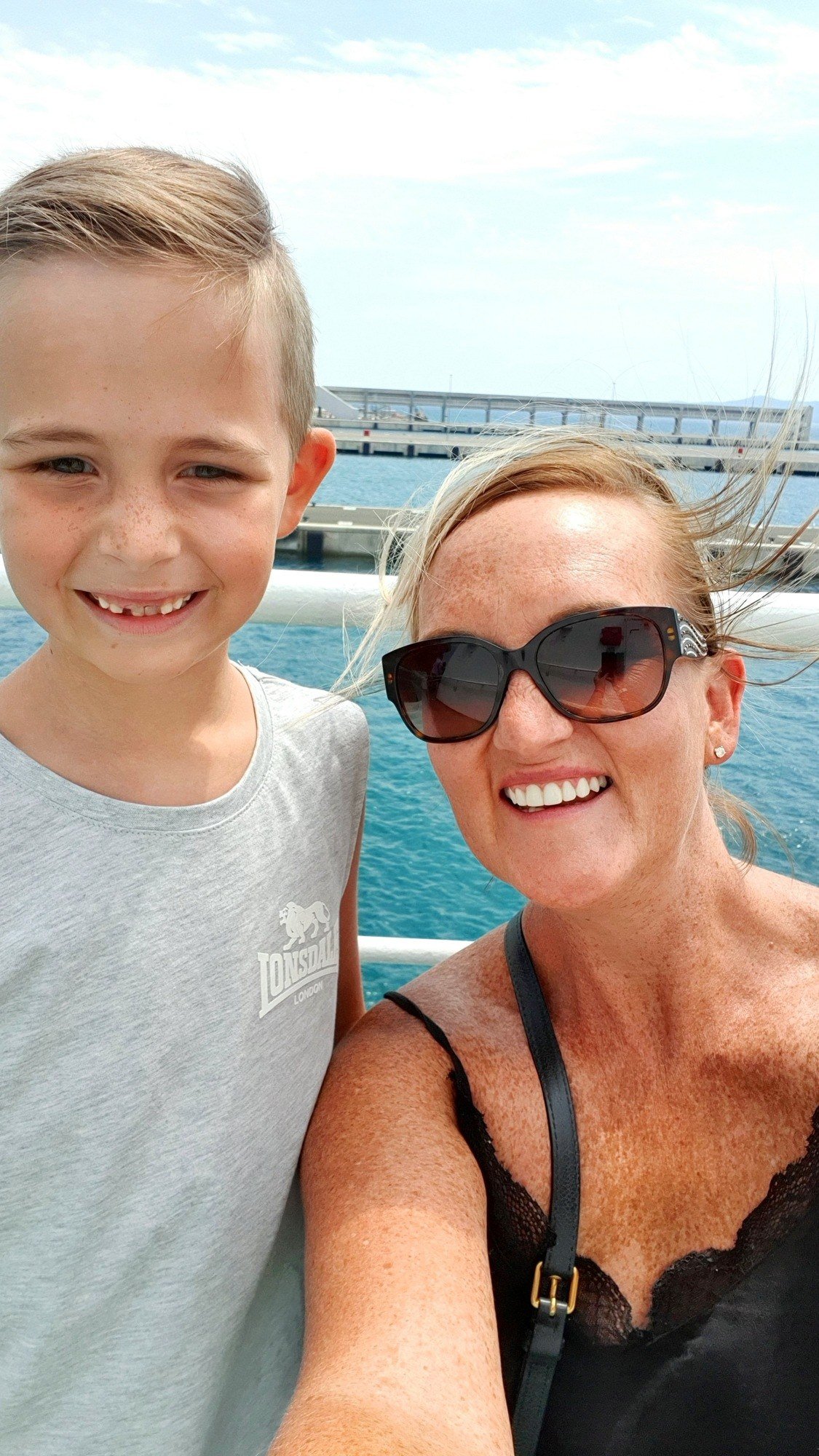
Having explored both Italy and Croatia extensively, I’ve gathered some personal experiences and travel tips that might help you navigate these countries more smoothly.
Driving In Italy: A Tale Of Two Experiences
Driving in the Italian countryside was an absolute delight. Picture this: rolling hills, vineyards stretching to the horizon, and those quaint little towns – it’s like driving through a postcard. However, when we decided to take our car into Rome, let’s say it was a different story.
In Rome, the traffic was overwhelming, and navigating the narrow, bustling streets felt like a scene from an action movie. We ended up returning the car just 15 minutes after driving into Rome from Puglia! My advice? Enjoy the countryside by car, but stick to public transport in the cities.
Italian Trains Vs. Croatian Trains: A Clear Winner
Trains in Italy? Spot on! They were clean, well-organized, and always seemed to run on time. Whether it was a high-speed train between major cities or a regional one meandering through lesser-known areas, the experience was consistently good.
On the other hand, trains in Croatia don’t quite match up. In fact, they are not really worth considering for travel at all, as they aren’t as extensive or reliable as other modes of transport here.
Living And Driving In Croatia: A Local’s Perspective
Living in Croatia, we’ve gotten entirely used to driving around. The roads are generally in good shape (but the tolls are pricey), and the views? It’s simply stunning, especially along the coast. But when it comes to navigating the trams in Zagreb, it can get a bit tricky.
It’s not that they’re complicated, but they do require a bit of getting used to. Once you get the hang of it, though, they’re a convenient way to get around the city.
Croatian Ferries: Efficient But Busy
The ferries in Croatia are a dream – clean, punctual, and offering some fantastic views of the Adriatic. But a word of caution: they get super busy in the summer.
If you plan to take your car on a ferry, I recommend getting there at least an hour early to avoid any last-minute rush. The queues can be long, and spaces fill up quickly. It’s always better to be early and secure your spot than to miss out on these essential connections between the islands and the mainland.
In conclusion, whether you’re driving through the picturesque landscapes of Italy or hopping on a ferry in Croatia, each experience has its own charm and challenges. With a bit of planning and these insider tips, you’ll be well-equipped to enjoy your journey in these beautiful Mediterranean countries.
Getting around Italy and Croatia is part of the adventure! Whether you’re zipping through historic cities or hopping between Croatian islands, understanding your transport options is key. Here’s a handy guide to help you navigate these beautiful countries with ease.
Transportation In Italy
Italy’s transport network is extensive and varied, offering multiple ways to explore the country’s diverse landscapes.
- Trains: Italy’s train network is a traveler’s dream. High-speed trains like Frecciarossa and Italo connect major cities like Rome, Milan, and Florence in a flash. For slower, scenic routes, regional trains are your go-to. Prices vary, but booking in advance can snag you some great deals
- Buses: Buses in Italy are a cost-effective way to reach places not accessible by train. Companies like FlixBus and MarinoBus offer long-distance routes, while local buses cover shorter distances
- Car Rentals: For ultimate flexibility, renting a car is a fantastic option, especially for exploring the countryside. Just remember, driving in Italian cities can be challenging due to traffic and limited parking
- Ferries: To visit islands like Sicily or Sardinia, ferries are your best bet. They’re frequent and offer a unique way to see Italy’s coastline
- Within Cities: Major cities have efficient public transport systems. Rome, Milan, and Naples boast metro systems, while Venice’s vaporettos (water buses) are a unique way to get around
Transportation In Croatia
Croatia’s beauty lies in its coastline and islands, and getting around here offers its own kind of thrill.
- Buses: Croatia’s bus network is extensive and reliable. It’s the most popular way to travel between cities and towns, with companies like Arriva and FlixBus running frequent services
- Trains: while Croatia’s train network isn’t as extensive as Italy’s, it’s an affordable option for routes like Zagreb to Split. However, for coastal and island destinations, buses and ferries are more practical
- Car Rentals: renting a car in Croatia gives you the freedom to explore at your own pace, especially for coastal drives and visiting national parks. The roads are generally good, and the scenery is stunning
- Ferries: essential for island hopping, ferries connect the mainland to islands like Hvar, Korcula, and Brač. Jadrolinija is the leading ferry operator, offering regular services
- Within Cities: cities like Zagreb, Dubrovnik, and Split are walkable and have good public transport networks for longer distances. Local buses are the main mode of city transport
Accommodation Differences Between Italy And Croatia

Planning where to stay in Croatia and Italy can be as exciting as choosing the destinations themselves. Both countries offer a variety of accommodations to suit any style and budget. Let’s break it down so you can find the perfect place to rest your head after a day of exploring.
Italy: A Blend Of Luxury And Cozy Stays
In Italy, you’re spoilt for choice. From high-end hotels in Rome and Florence to quaint B&Bs in the countryside, there’s something for everyone.
- Luxury Hotels: in major cities and tourist hotspots like Venice or the Amalfi Coast, expect to find luxury hotels oozing with elegance. But remember, luxury here comes with a price tag – think upwards of €200 a night
- Mid-range Hotels: for something less splurgy but still comfortable, mid-range hotels in Italy offer decent amenities. Prices range from €100 to €200 per night, depending on the location
- Budget Options: if you’re keeping an eye on your euros, hostels and budget hotels are your friends, especially in big cities. Prices can be as low as €30-€50 a night
- Vacation Rentals: fancy living like a local? Vacation rentals, like Airbnb, are increasingly popular, giving you a home-away-from-home experience. Prices vary widely, from budget-friendly to luxury
Croatia: From Coastal Retreats To Affordable City Stays
Croatia’s accommodation scene is diverse, with a focus on affordable luxury and charming local stays.
- Seaside Resorts: along the coast, especially in places like Dubrovnik and Split, you’ll find beautiful resorts. They’re a bit pricier but offer stunning sea views. Expect to pay around €100-€250 per night
- City Hotels: in cities, hotels range from luxury to more affordable options. Prices in the capital city of Zagreb or Split can range from €50 to €150 per night
- Hostels and Guesthouses: for budget travelers, hostels and guesthouses are the go-to. They’re affordable (around €20-€40 a night) and often come with a warm, local vibe
- Private Rentals: like in Italy, private rentals are a great way to immerse yourself in Croatian life. They vary in price, but you can find some great deals, especially off the beaten path
A Few Tips For Your Stay

- Book in Advance: especially during peak seasons, booking your accommodation early can save you from last-minute price hikes
- Location Matters: consider staying a bit outside popular tourist areas for better deals. Public transport in both Italy and Croatia is pretty reliable
In summary, whether you’re looking for luxury, comfort, or a budget-friendly option, Italy and Croatia offer a wide range of accommodations to fit your needs and wallet.
Croatia Or Italy For Natuitcal Tourism
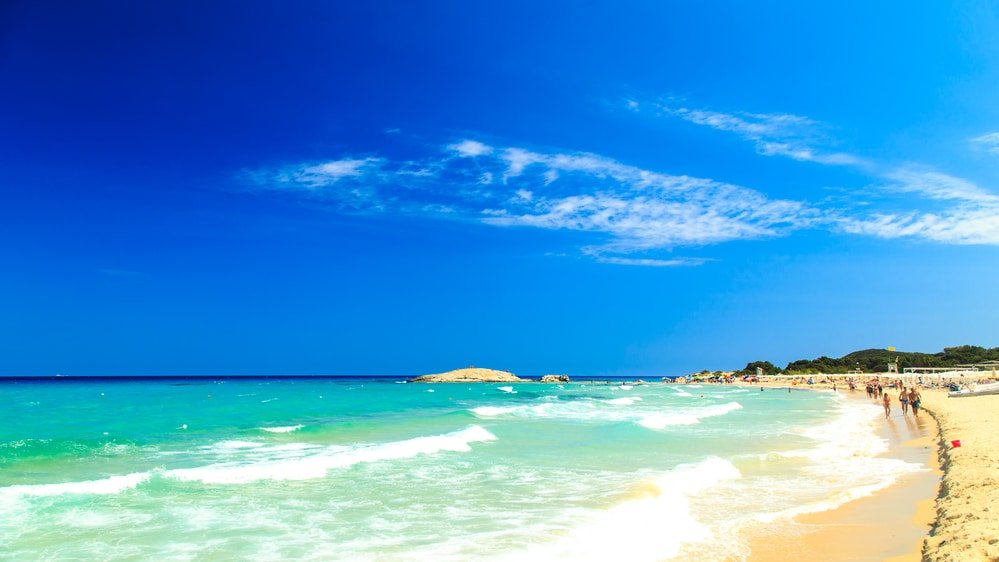
Are you torn between Italy and Croatia for your next sea adventure? Both countries are renowned for their exceptional nautical tourism, but each offers its own unique experience. Let’s dive into what makes these two Adriatic jewels stand out, helping you decide your next maritime destination.
Italy’s Nautical Charm: A Blend Of Luxury And History
Sailing in Italy isn’t just a trip; it’s a plunge into a rich historical sea. The Italian coastline is dotted with ancient ports and modern marinas, offering a luxurious sailing experience.
Here, you can glide through the waters, stopping at historic towns and indulging in world-famous Italian cuisine. The Italian Riviera, Amalfi Coast, and the islands of Sicily and Sardinia aren’t just places on a map; they’re chapters in your Italian sea story.
Croatia’s Coastal Wonders Untouched And Captivating
Croatia, on the other hand, is a treasure trove of natural beauty. Its coast is lined with pristine beaches, many accessible only by boat.
The Dalmatian Coast, with its clear waters and idyllic islands, is perfect for those seeking a blend of tranquility and adventure. Croatia’s nautical scene is less about luxury and more about connecting with nature and discovering hidden coves and secluded beaches.
Sailing Options From Yachts To Catamarans
Whether you pick Italy or Croatia, your vessel choices are plenty. Luxurious yachts, speedy motorboats, and agile catamarans are available for charter in both countries.
In Italy, you might lean towards more stylish and opulent options, while in Croatia, practical and versatile boats are the norm, ideal for exploring lesser-known spots.
Navigation And Route
Navigating these waters is a delight for sailors of all levels. Both Italy and Croatia offer well-mapped routes, but the real fun lies in charting your own path. Italy’s extensive nautical history means you’ll be sailing routes taken by ancient mariners, while Croatia offers the thrill of discovering uncharted territories.
Discovering Hidden Treasures: Italy and Croatia’s Secluded Spots
Exploring Italy and Croatia by sea unveils hidden treasures perfect for those seeking serenity and unspoiled beauty. Here’s a look at some of the most captivating secluded spots in both countries.
Amalfi’s Tranquil Haven
Along the celebrated Amalfi Coast, there’s a hidden retreat accessible only by the sea. This secluded spot is a haven for peace-seekers. Here, you can anchor in transparent waters encircled by stunning landscapes, offering a serene escape from the well-trodden tourist paths. Ideal for those who wish to experience the Amalfi Coast’s more peaceful side, this secret retreat promises tranquility amidst breathtaking natural beauty.
Stiniva Beach: Vis Island’s Secret Cove
On the Croatian island of Vis, Stiniva Beach awaits as a hidden gem. Concealed behind a narrow passage, it opens up to a striking cove, offering a private, almost exclusive beach experience. This spot is a shining example of Croatia’s nautical allure, providing tranquility away from the bustling crowd. Stiniva Beach stands as a testament to Croatia’s unspoiled and lesser-known spots.
Cala Goloritzè: Sardinia’s Secluded Paradise
In Sardinia, Cala Goloritzè is accessible solely by boat or a challenging trek. This pristine beach, known for its turquoise waters and a striking natural limestone arch, is the epitome of seclusion. Its remote location makes it an ideal spot for those in search of solitude and natural beauty.
Paklinski Islands: Croatia’s Hidden Archipelago
Near Hvar, the Paklinski Islands are a group of small isles featuring hidden coves and crystal-clear waters. These islands are home to secluded beaches like Palmižana, where lush greenery meets the Adriatic’s azure waters in perfect harmony. The Paklinski Islands are perfect for explorers who wish to discover Croatia’s more intimate and untouched coastal areas.
All of these locations offer a unique experience – from the serene Italian coasts to the tranquil Croatian islands. They are ideal for sailors and adventurers looking to escape the usual and immerse themselves in the natural splendor of these two Mediterranean gems.
Comparing Italy and Croatia’s Nautical Experiences: Pros and Cons
When it comes to choosing a nautical destination, Italy and Croatia both offer fantastic experiences with distinct characteristics. Here’s a breakdown of the pros and cons of each to help you make an informed decision.
Italy’s Nautical Scene
Pros:
- Historical Legacy: Italy’s long maritime history is woven into its culture, offering a rich and immersive sailing experience.
- Iconic Destinations: sail to world-famous spots like the Amalfi Coast, where beauty and history meet the sea
- Diverse Fleet: Italy’s range of boats is impressive, from vintage sailboats to sleek, modern yachts
Cons:
- Higher Costs: generally, sailing in Italy can be pricier than other Mediterranean options
- Crowded Waters: popular destinations can get quite busy, particularly during the peak tourist season
Croatia’s Nautical Scene
Pros:
- Untouched Beauty: Croatia offers pristine, less crowded beaches, ideal for those seeking tranquility
- Authentic Coastal Charm: discover small, picturesque villages along the coast that offer a genuine local experience
- Affordable Charters: compared to Italy, Croatia provides more budget-friendly options for boat charters
Cons:
- Limited Luxury Charters: high-end, luxury boat options might be less available than in Italy
- Rustic Seclusion: some of Croatia’s remote beaches lack the amenities found in more developed areas
In summary, Italy’s nautical offerings are steeped in history with a range of boat options but come at a higher cost and with potentially crowded locales. Croatia, while more budget-friendly and tranquil, may lack the luxury options and amenities found in more popular destinations. Your choice depends on what you value most in your maritime adventure.
Food In Croatia Vs. Italy – A Gastronomic Journey
When it comes to good food, Croatia and Italy both offer a tempting array of dishes that reflect their rich histories and diverse landscapes. Let’s embark on a culinary tour to compare the mouth-watering cuisines of these Mediterranean neighbors.
Italy: A Symphony of Flavors in Every Bite

Italian cuisine needs no introduction. It’s a delightful mix of regional specialties, each with its own unique twist.
Pasta and Pizza: from the al dente perfection of Roman pasta to the cheesy heaven of Neapolitan pizza, Italy is the ultimate carb paradise and birthplace of pizza. But it’s not just about these global favorites – each region boasts its own pasta specialty, be it the creamy risottos of the north or the spicy arrabbiata of the south.
Seafood and Meats: coastal regions like Sicily serve up some of the freshest seafood, while Tuscany and Umbria are all about hearty meats and game. Don’t miss the prosciutto from Parma or the bistecca alla fiorentina in Florence.
Wine and Cheese: Italy’s vineyards produce world-class wines, and the cheeses – oh, the cheeses! From the sharp Parmigiano-Reggiano to the soft buffalo mozzarella, they’re a cheese lover’s dream. And all that cheese pairs perfectly with a wine tasting.
Sweets: end your meal with a tiramisu, cannoli, or a scoop of gelato. Trust me, Italian desserts are in a league of their own.
Croatia: A Hidden Culinary Gem

Croatian cuisine is a hidden treasure waiting to be discovered, characterized by a blend of Mediterranean and Slavic influences.
Seafood Galore: thanks to its long coastline, seafood is a star in Croatian cuisine. Grilled fish, octopus salad, and black risotto are must-tries. The oysters from Ston are a delicacy not to be missed.
Meat Dishes: inland regions excel in hearty meat dishes. Ćevapi (grilled sausages) and peka (meat and vegetables cooked under a bell-shaped lid) are traditional favorites.
Truffles and Olive Oil: the Istrian peninsula is famous for its truffles and top-quality olive oil. If you’re there, a truffle pasta dish is a must.
Wines and Spirits: Croatian wines, like the robust red Plavac Mali or the crisp white Malvazija, are gaining international acclaim. And for a truly local experience, try rakija, a potent fruit brandy.
Italy Vs. Croatia: A Feast for the Senses
In Italy, the food scene is like a well-rehearsed orchestra, with each region playing its part to perfection. In Croatia, it’s more like a delightful jam session where unexpected flavors harmonize to create something truly unique.
Whether you’re savoring a slice of pizza overlooking a bustling piazza in Rome or enjoying a fresh seafood feast on a tranquil Croatian beach, the culinary experiences in both countries are as memorable as their stunning landscapes. So, fork in hand, get ready to dive into the diverse, rich, and utterly delicious cuisines of Italy and Croatia. Buon appetito or dobar tek!
Move This Adventure To Your Inbox & Get An Instant Freebie

No spam. Unsubscribe at any time.
Weather Wise Will It Be Italy Or Croatia
Deciding when to visit Italy and Croatia is like choosing the perfect seasoning for your favorite dish. It’s all about timing and what you’re looking for in your vacation, weather-wise.
Let me give you the lowdown on the climate and the best times to visit these Mediterranean beauties.
Italy: From Sunny Beaches To Snowy Peaks
Italy’s weather can be as diverse as its landscapes.
Spring (April to June): this is a golden time to visit. The weather is pleasantly warm, perfect for exploring cities without the swelter of summer. The countryside is in full bloom, and the tourist crowds haven’t peaked yet.
Summer (July to August): expect it to be hot, especially in the south and in cities like Rome and Florence. It’s beach season, so coastal areas like the Amalfi Coast are buzzing with life. But remember, it’s also peak tourist season so things can get crowded.
Autumn (September to October): my personal favorite. The heat eases off, the summer crowds disperse, and the countryside turns into a palette of warm colors. Plus, it’s grape harvest season in the wine regions – a real treat!
Winter (November to March): in the north, you’ll find snowy mountains perfect for skiing. Elsewhere, it’s cooler and quieter, ideal for city exploring without the crowds. Christmas in Italy is one magical time, but do expect some places, especially along the coast, to be closed for the season.
Croatia: Sun-Kissed Shores And Crisp Winters
Croatia’s climate is generally Mediterranean along the coast and continental inland.
Spring (April to June): Spring in Croatia is stunning. The Adriatic coast begins to warm up, and the national parks are beautifully lush. It’s a sweet spot before the summer rush.
Summer (July to August): Croatian summers are all about crystal-clear waters and sun-soaked islands. But just like in Italy, it’s the busiest and hottest time, especially on the coast. If you love the buzz and don’t mind the heat, it’s party time.
Autumn (September to October): the water is still warm enough for swimming, and the summer crowds have thinned out. The weather is mild – great for exploring cities and outdoor activities.
Winter (November to March): it’s quieter and cooler, with some rain. While the coastal areas go into hibernation mode, Zagreb lights up with Christmas markets. It’s not ideal for beach-goers, but city explorers and winter festival lovers will have a ball.
In both countries, the shoulder seasons – spring and autumn – are my top picks for the best weather without the extreme crowds.
But hey, if you’re a sun worshipper or a snow bunny, summer and winter have their own charms.
Just pick what suits your travel style best, and you’re all set for an exceptional Mediterranean experience.
Croatia And Italy: Which Is Safe
Exploring new places is thrilling, but keeping safety and health in mind is crucial, especially when you’re in unfamiliar territory.
Here’s a quick travel planning guide on staying safe and healthy in Italy and Croatia so you can enjoy your trip worry-free.
Safety in Italy
General Safety: Italy is generally safe for travelers. However, like in any popular tourist destination, watch out for pickpockets, especially in crowded areas like Rome’s Trevi Fountain or Milan’s Duomo. Keep your belongings secure and be aware of your surroundings.
Healthcare: Italy’s healthcare system is top-notch. If you need medical attention, public hospitals and private clinics are available. Remember, it’s always wise to have travel insurance that covers healthcare.
Emergency Contacts: in case of emergency, dial 112. This is the general emergency number in Italy, connecting you to police, fire, and medical services.
Safety in Croatia
General Safety: Croatia is known for being relatively safe for tourists. The usual advice applies: be cautious of your belongings and stay vigilant in busy tourist spots and nightlife areas.
Healthcare: Croatia has a good standard of healthcare. Pharmacies are widely available, and hospitals provide adequate care. However, some remote islands and rural areas might have limited facilities.
Emergency Contacts: the emergency number in Croatia is also 112. It’s a good idea to keep this number handy on your phone.
Which Country Is Better Wrap-Up
Choosing between Italy and Croatia for a seaside holiday? Both boast beautiful beaches, but each offers distinct experiences for travelers.
Italy’s rich history is evident along its coast, from the Roman Empire relics to the luxurious Amalfi Coast. For adventure seekers, Italy’s diverse attractions, including bustling coastal towns and serene beaches, provide an ideal setting for both road trips and day trips.
Croatia, on the other hand, offers a serene escape with its unspoiled landscapes along the Adriatic Sea. It’s a haven for those looking to unwind in crystal-clear waters, with Dubrovnik’s historic charm adding to the allure.
Both countries are worth visiting for their unique blend of natural beauty, history, and adventure opportunities. Your choice depends on whether you prefer Italy’s timeless allure and a wide array of attractions or Croatia’s tranquil coasts and natural splendor.
untouched natural beauty that calls to you, a trip here means more than just sailing – it’s about creating memories that stick with you long after you’ve left the sea behind.
So, ready your sails and get set for an unforgettable Mediterranean journey in either Italy or Croatia.
Transport From Croatia To Italy
Let’s face it, you have now decided you can’t choose, right? Well, in that case, here is how you can travel between these two Adriatic titans.
Traveling between Croatia and Italy is a breeze; whether you’re a fan of the skies or seas, here’s what you need to know:
Flights
You’ve got options! Major Croatian cities like Zagreb, Split, and Dubrovnik offer direct flights to Italian hotspots such as Rome, Milan, and Venice. Choosing a direct flight can make your trip smoother and quicker.
Ferry Connections
If you’re up for a scenic journey, ferries are the way to go. They’re not just a great way to see the Adriatic but also let you bring your car along. This means you can hit the road as soon as you dock, exploring at your own pace.
The main Croatian ports for ferry travel to Italy are Pula, Rijeka, and Zadar. From here, hop on a fast Catamaran that cruises at about 40mph, and you’ll be stepping onto Italian shores in 3 to 4 hours. Plus, it’s wallet-friendly. For instance, a round trip from Pula to Venice can cost around 50 Euros.
Ideal Ports
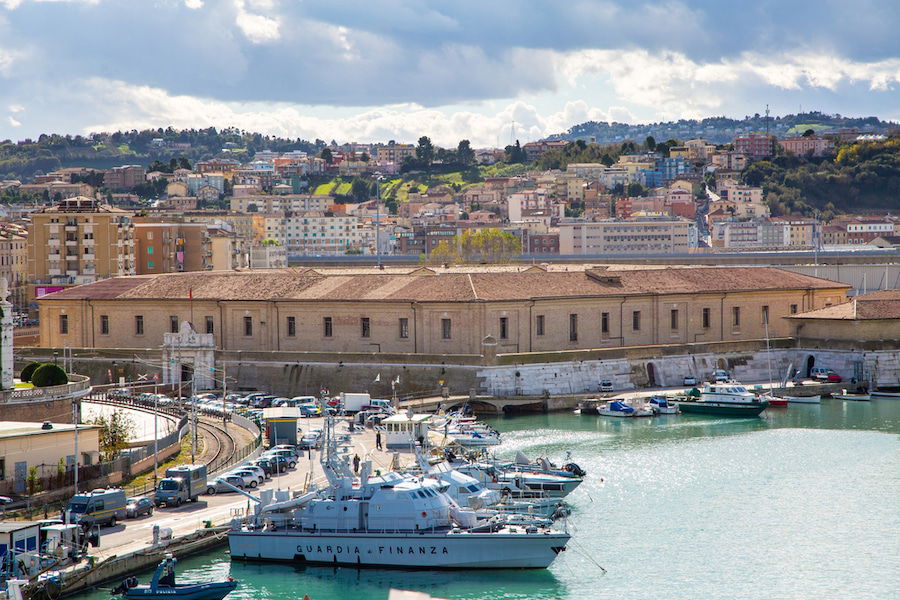
- Pula: This Croatian gem is a great starting point. It’s soaked in medieval history and offers the quickest ferry route to Italy
- Ancona: Over in Italy, Ancona is your gateway. It’s well-connected and makes getting around the Italian regions a piece of cake
Rail Connection

Are you looking for a bit of adventure on rails and roads? While there’s no direct train from Croatia to Italy, you can still make the journey with a mix of train and bus.
Start by taking a train to a Slovenian border city, then switch to a bus. Once you reach Trieste in Italy, you can hop on a train again to continue your Italian escapade. It’s a longer route, sure, but it’s a unique way to see more of the landscape and experience local life. Plus, it’s perfect if you’re in no rush and up for a bit of exploration.


